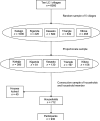Active case finding of undetected tuberculosis among chronic coughers in a slum setting in Kampala, Uganda
- PMID: 19335958
- PMCID: PMC2842997
Active case finding of undetected tuberculosis among chronic coughers in a slum setting in Kampala, Uganda
Abstract
Setting: Kisenyi slum in peri-urban Kampala, Uganda.
Objectives: Using chronic cough (> or = 2 weeks) inquiry as a screening tool to identify undetected smear-positive tuberculosis (TB) cases and to describe the characteristics of smear-positive TB cases detected by active case finding.
Design: A house-to-house survey was conducted in five randomly selected villages in Kampala between June and August 2005. A sample of households was visited; adults aged > or = 15 years were consecutively interviewed to identify those with chronic cough. Three sputum specimens were collected and examined by smear microscopy.
Results: Among 930 individuals, we identified 189 (20%) chronic coughers. Of these, we found 33 (18%) undiagnosed smear-positive cases. The newly detected cases had an even sex distribution (P = 0.47), a median age of 30 years, a median cough duration of 1 month and 55% had acid-fast bacilli 1+ sputum smear grade.
Conclusion: These findings suggest that active case finding could supplement DOTS to yield additional smear-positive TB cases, lead to early diagnosis and thus shorten the duration of infectiousness before effective chemotherapy is initiated. In communities such as Kisenyi, this is a feasible strategy that may prove useful for TB control, but its cost-effectiveness needs to be evaluated. Early health care seeking for cough should be emphasized.
Figures
Similar articles
-
Yield of undetected tuberculosis and human immunodeficiency virus coinfection from active case finding in urban Uganda.Int J Tuberc Lung Dis. 2014 Jan;18(1):13-9. doi: 10.5588/ijtld.13.0129. Int J Tuberc Lung Dis. 2014. PMID: 24365547 Free PMC article.
-
Follow-up of chronic coughers improves tuberculosis case finding: results from a community-based cohort study in southern Ethiopia.PLoS One. 2015 Feb 26;10(2):e0116324. doi: 10.1371/journal.pone.0116324. eCollection 2015. PLoS One. 2015. PMID: 25719541 Free PMC article.
-
Efficiency of a third serial sputum smear examination in the diagnosis of tuberculosis in Moldova and Uganda.Int J Tuberc Lung Dis. 2007 Jun;11(6):659-64. Int J Tuberc Lung Dis. 2007. PMID: 17519098
-
Clinical predictors and accuracy of empiric tuberculosis treatment among sputum smear-negative HIV-infected adult TB suspects in Uganda.PLoS One. 2013 Sep 6;8(9):e74023. doi: 10.1371/journal.pone.0074023. eCollection 2013. PLoS One. 2013. PMID: 24040151 Free PMC article.
-
Tuberculosis.In: Holmes KK, Bertozzi S, Bloom BR, Jha P, editors. Major Infectious Diseases. 3rd edition. Washington (DC): The International Bank for Reconstruction and Development / The World Bank; 2017 Nov 3. Chapter 11. In: Holmes KK, Bertozzi S, Bloom BR, Jha P, editors. Major Infectious Diseases. 3rd edition. Washington (DC): The International Bank for Reconstruction and Development / The World Bank; 2017 Nov 3. Chapter 11. PMID: 30212088 Free Books & Documents. Review.
Cited by
-
The effect of engaging unpaid informal providers on case detection and treatment initiation rates for TB and HIV in rural Malawi (Triage Plus): A cluster randomised health system intervention trial.PLoS One. 2017 Sep 6;12(9):e0183312. doi: 10.1371/journal.pone.0183312. eCollection 2017. PLoS One. 2017. PMID: 28877245 Free PMC article. Clinical Trial.
-
Interventions to increase tuberculosis case detection at primary healthcare or community-level services.Cochrane Database Syst Rev. 2017 Nov 28;11(11):CD011432. doi: 10.1002/14651858.CD011432.pub2. Cochrane Database Syst Rev. 2017. PMID: 29182800 Free PMC article.
-
Yield of HIV-associated tuberculosis during intensified case finding in resource-limited settings: a systematic review and meta-analysis.Lancet Infect Dis. 2010 Feb;10(2):93-102. doi: 10.1016/S1473-3099(09)70326-3. Lancet Infect Dis. 2010. PMID: 20113978 Free PMC article.
-
Active detection of tuberculosis and paragonimiasis in the remote areas in North-Eastern India using cough as a simple indicator.Pathog Glob Health. 2013 Apr;107(3):153-6. doi: 10.1179/2047773213Y.0000000086. Pathog Glob Health. 2013. PMID: 23683370 Free PMC article.
-
Socio-demographic determinants and prevalence of Tuberculosis knowledge in three slum populations of Uganda.BMC Public Health. 2012 Jul 23;12:536. doi: 10.1186/1471-2458-12-536. BMC Public Health. 2012. PMID: 22824498 Free PMC article.
References
-
- Siddiqi K, Lambert ML, Walley J. Clinical diagnosis of smear-negative pulmonary tuberculosis in low-income countries: the current evidence. Lancet Infect Dis. 2003;3:288–296. - PubMed
-
- World Health Organization . WHO reports 10 million TB patients successfully treated under ‘DOTS’ 10 years after declaring TB a global emergency. WHO; Geneva, Switzerland: 2003.
Publication types
MeSH terms
Grants and funding
LinkOut - more resources
Full Text Sources
Medical



